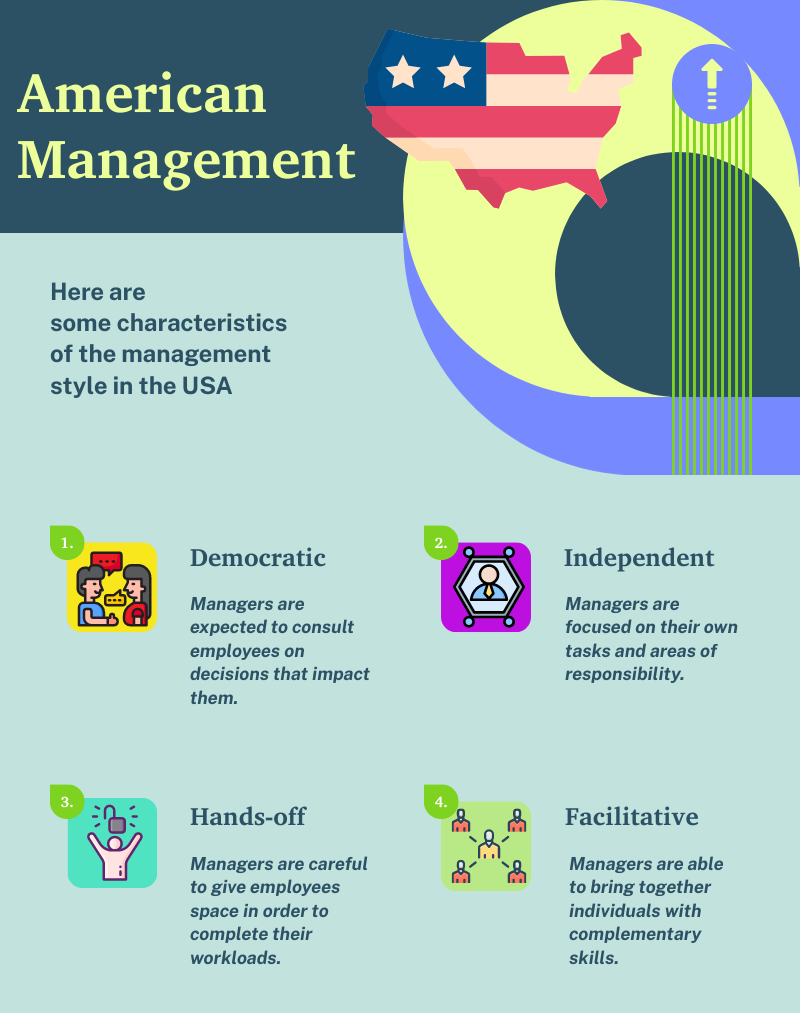
Cross Cultural Management Guide for the USA
The guidance below is for managers who want to learn more about the management style and business culture of the USA.
It provides some useful information for managers who are relocating to the country for employment as well as those who may have American employees in their global or multicultural teams.
Topics include:
- Hierarchy
- Leadership style
- Time and scheduling
- Communication style
- Negotiation
Being a Manager in the United States of America
The management style in the USA can vary greatly depending on the industry, company culture, and individual managers. However, there are some common styles that are prevalent in many organizations across the country.
- One popular management style in the USA is the democratic style, which emphasizes employee participation in decision-making and a collaborative approach to problem-solving.
- This style can be effective in fostering employee engagement and buy-in, as well as generating innovative ideas and solutions.
- Another common management style in the USA is the authoritarian style, which is characterized by a top-down approach to decision-making and a focus on strict adherence to rules and procedures.
- While this style can be effective in certain situations, such as in industries where safety is a major concern, it can also lead to employee dissatisfaction and disengagement if not balanced with opportunities for input and feedback.
- A third management style that is gaining popularity in the USA is the servant leadership style, which prioritizes the needs and development of employees above the leader's interests.
- This approach can be effective in building trust and loyalty among employees, as well as promoting a positive company culture.
- Overall, the management style in the USA is influenced by a variety of factors, including cultural values, business objectives, and individual preferences.
- Effective managers can adapt their style to the needs of their organization and employees and continually strive to improve their leadership skills.
The Role of a Manager
The role of a manager is to recognize, value and bring together the specialized knowledge that different employees, at all levels, bring.
- Employees expect to be consulted on decisions that affect them and the greater good of the organization.
- The American working environment has changed drastically over recent years; with one eye on costs and the other on retention, employers are increasingly offering part-time or shared jobs, or outsourcing to external contractors.
- Change is constant as companies are restructured, work teams become "virtual," and flexible work arrangements become more common.
Approach to Change
The USA has a high tolerance for risk and an acceptance for change.
- The underlying mindset is that change, while difficult, usually brings improvements and enhancements with it.
- Making a mistake is not seen as a failure but rather a learning or growing experience; failure is seen simply as a step towards success.
- Managers are not afraid to discuss failure or error openly with their teams.
- Change is usually adopted easily as long as a clear case for progress, ease or improvement is made.
Approach to Time and Priorities
The USA is a controlled-time culture. This is a culture that believes 'time is money'.
- Missing a deadline is a sign of poor management and inefficiency, and will shake people’s confidence.
- Successful management will depend on the individual’s ability to meet deadlines.
Decision Making
American managers are viewed as facilitators -people who help employees do their best work -and not simply decision-makers.
- They empower employees and expect them to take responsibility.
- Employees freely cross management levels and speak directly to senior managers.
- This freedom is particularly apparent at meetings, where everyone in attendance is encouraged to participate openly.
Boss or Team Player?
In the USA employees work independently but cohesively as a team. Whether the manager is a boss or team player depends a lot on the industry.
- Members are generally chosen to participate based on tangible skills or the knowledge base they bring and are equally welcome to contribute to any discussion that may arise.
- They are encouraged to generate new ideas that may further the direction of the plan or spawn a new track entirely.
- In successful, dynamic teams, all members are valued for their actual and potential contributions, and all are treated with equal respect.
Communication and Negotiation Styles
The American negotiating style tends to be direct. A "hard sell", sometimes characterized as sledgehammer subtlety combined with missionary zeal, is not uncommon.
- A strong pitch may sound boastful but is meant to inspire confidence and trust. It is also consistent with the penchant for logical reasoning, directness and comfort with self-promotion.
- American negotiators may have little familiarity with, or patience for, the formal business protocol, indirect communication style, or consensual decision-making practices of other countries (a fact that savvy international negotiators often use to their advantage).
- Their focus is on the short term and the "big picture" -- securing the best deal promptly.
- Their approach is informal, cordial and straightforward.
- The U.S. team will reveal its position and expect the other party to engage in a competitive bargaining process.
- If an impasse is reached, American tenacity, creativity, and persuasiveness will come to the fore.
- Despite the "hard sell" tactics, negotiating partners should not feel pressured into making a decision.
- The Americans expect their counterparts across the table to be similarly pragmatic and single-minded in trying to secure a favourable deal.

Get Expert Insights
This online USA cultural awareness course will help you navigate American business culture.
Learn to make a great impression, create trusting relationships and maximise your business performance!

 +44 0330 027 0207 or +1 (818) 532-6908
+44 0330 027 0207 or +1 (818) 532-6908

